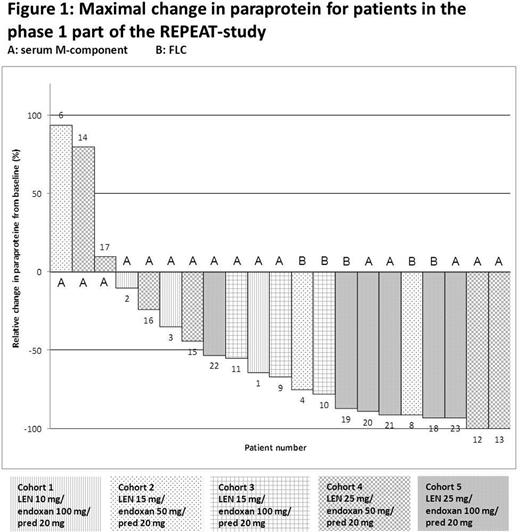Abstract
The outcome of multiple myeloma (MM) patients who are no longer responding to thalidomide, lenalidomide (LEN) and bortezomib (BORT) is very poor, with a median event-free survival of 5 months and median overall survival (OS) of 9 months (Kumar SK et al, Leukemia 2012; 26;149-157). We have previously shown in a small retrospective study that the combination of continuous low dose oral cyclophosphamide (endoxan) and prednisone combined with lenalidomide (REP) had remarkable activity in heavily pretreated LEN-refractory multiple myeloma patients (median 6 lines of previous chemotherapy) (vd Donk et al; Br J Haematol 2010;148(2):335-7). To determine the optimal dose of lenalidomide with continuous cyclophosphamide and prednisone, we initiated a prospective study to evaluate the maximum tolerated dose (MTD) of the REP regimen and to assess its efficacy and safety in LEN-refractory MM patients. Here we report safety and efficacy data from the phase 1 dose-escalation part of the REPEAT-study (NCT01352338).
Patients aged ≥ 18 years with LEN-refractory MM, ECOG-performance status 0-3 and adequate kidney, liver and hematologic function were included. Five dose levels were evaluated using a standard 3+3 design, based on dose-limiting toxicities (DLTs) occurring in cycle 1. Patients received LEN in doses ranging from 10-25 mg/day on days 1-21 of 28-day cycle, while oral cyclophosphamide (50 or 100 mg) and prednisone (20 mg) were given continuously. Therapy was continued until progression. The MTD for the phase 2 part is defined as the highest dose level with 0 or 1 DLT's observed in 6 patients.
Up till now, 35 patients were enrolled (22 in phase 1 and 13 in phase 2) from August 2011 to June 2013. The phase 2 part is still recruiting and data are not evaluable yet. One patient in phase 1 was excluded because of study violation and is not included in the analysis. The median age of the 21 evaluable patients in phase 1 was 69 years (range 41-73); 76% were male. The median duration of the disease from diagnosis was 41 months (range 18-96), median number of prior therapies was 3 (range 2-6), and 12 patients (57%) had previously received autologous SCT. All patients were LEN-refractory, 19 (90%) had prior BORT treatment, and 16 (76%) had BORT-refractory MM. Fifty-five % of the patients were considered high risk by FISH. At the time of analysis, 16 of 21 patients in phase 1 have discontinued treatment because of disease progression (13), alternative treatment (allo-SCT) (1), or adverse events (2). The MTD was defined as LEN 25 mg days 1-21 of a 28-day cycle, combined with oral cyclophosphamide 50 mg and prednisone 20 mg continuously (dose level 4), based on three patients experiencing a DLT: two developed pneumonia (in dose levels 4 and 5; CTC grade 3), and one patient at dose level 5 experienced CTC grade 3 dyspnea. Neutropenia (18%) and thrombocytopenia (18%) were the most common grade 3 hematological adverse events (AEs), which were managed with growth factor support and/or dose modification. There were no grade 4 hematologic AEs. Grade 3 respiratory tract infections (29%) and grade 2 fatigue (19%) were the most common non-hematological AEs. Venous thromboembolism occurred in 1 patient.
Figure 1 shows a waterfall plot of the responses of the patients that participated in the phase 1 part of the study. Overall response rate (≥ PR) was 67% with 6 out of 21 (29%) patients achieving at least VGPR. In addition 2 patients achieved MR (≥ MR: 76%). Median PFS and OS were 6.3 and 15.5 months respectively. Similar results were achieved in the subset of patients with LEN- and BORT-refractory disease. Interestingly, laboratory experiments with purified myeloma cells from these patients suggest synergism between LEN and cyclophosphamide.
The REP regimen induces high response rates and prolonged PFS and OS in LEN-refractory patients with acceptable toxicity. The MTD is defined as LEN 25 mg days 1-21 of a 28-day cycle, combined with oral cyclophosphamide 50 mg and prednisone 20 mg continuously. Phase 2 is enrolling patients and evaluates efficacy and safety of the REP regimen at the MTD. REP should be considered a valuable salvage option for LEN-refractory MM patients. We will present an updated follow-up at ASH.
Sonneveld:Onyx: Research Funding; Millenium: Research Funding; Janssen-Cilag: Research Funding; Onyx: Honoraria; Celgene: Honoraria; Janssen-Cilag: Honoraria; Celgene: Research Funding. Lokhorst:Genmab A/S: Consultancy, Research Funding; Celgene: Honoraria; Johnson-Cilag: Honoraria; Mudipharma: Honoraria. van de Donk:Celgene: Research Funding.
Author notes
Asterisk with author names denotes non-ASH members.


This feature is available to Subscribers Only
Sign In or Create an Account Close Modal